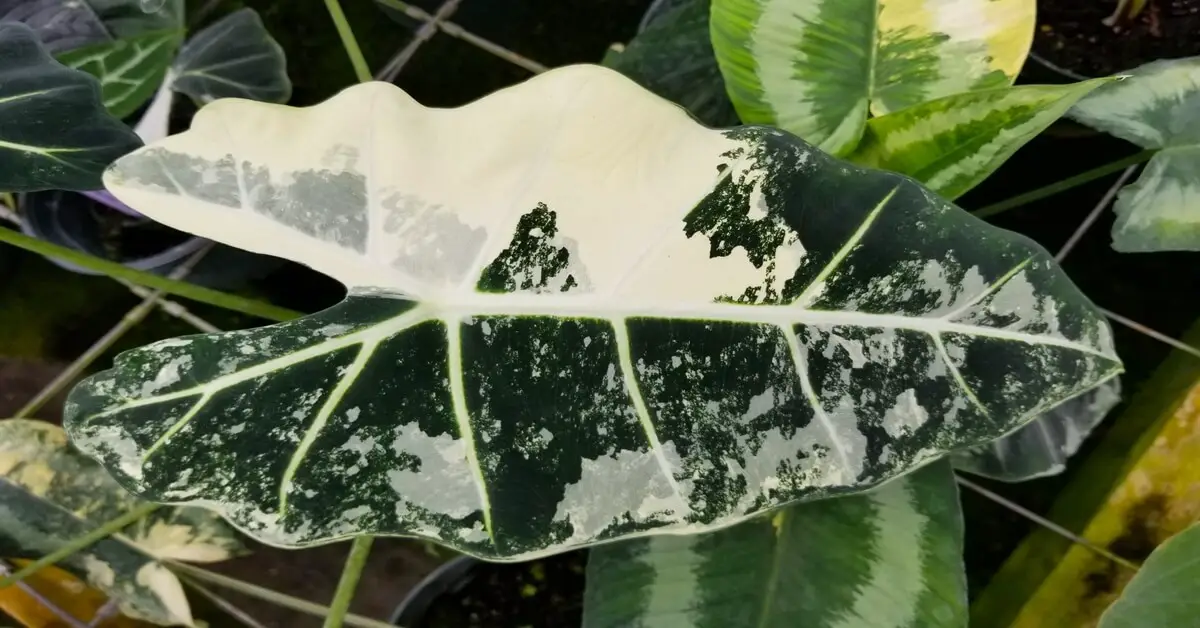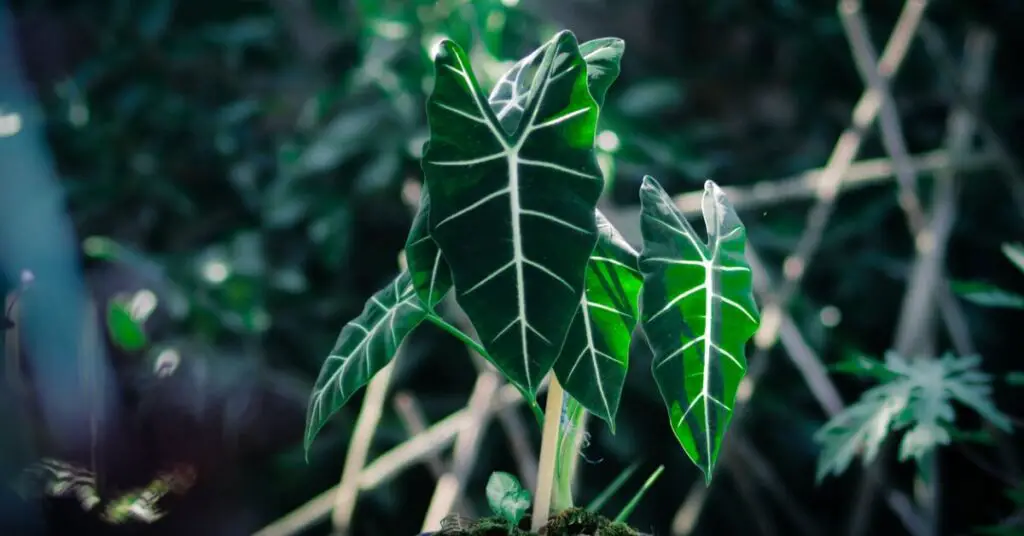Alocasia Micholitziana, or Frydek or Green Velvet, is a popular houseplant from the Philippines. However, this plant isn’t popular because of its ease of use—it can be challenging to care for. Here, we’ll give you all the information on how to grow a thriving Green Velvet in your home or garden.
If you’re interested in growing other plants outdoors in North Carolina, check out our guide on year-round backyard vegetable gardening to ensure your garden thrives in every season.
Alocasia Frydek Care
Just as with any plant, there are several elements to consider when giving it proper care. Although this might seem overwhelming at first, once you get the hang of what your particular plant species needs, caring for it becomes second nature.
Lighting
Alocasia Frydeks need bright, indirect light. If your plant gets more than an hour or two of direct sunlight, it will scorch and wither. However, if it gets too little light, it won’t thrive. Try a place that casts a shadow but doesn’t have direct sunlight.
Watering
When the top inch or two of the Alocasia’s soil is dry, water it enough so that the soil feels wet to the touch. It will use varying amounts of water depending on the time of year, temperature, and whether or not the Frydek is growing.
In winter, for example, your plant will need less water to prevent root rot. Thus, monitor the soil before deciding to water instead of following an exact schedule. When you water, turn the pot about a quarter so your plant grows evenly.
Soil
Green Velvets do best in well-draining yet fertile soil. A good mix usually consists of the majority peat (about 60%), a substantial amount of perlite (about 30%), and a bit of compost or worm castings (10%). You can also buy pre-made soil for alocasias, which is a good option if you’re starting with these plants.
Choosing the right soil mix is essential for any plant. If you’re looking to expand your garden, this guide on container gardening for vegetables provides tips on achieving a productive harvest in small spaces.
If you want a hassle-free way to get started, consider using pre-made Alocasia soil mix designed for optimal drainage and aeration.
Fertilizer
When the alocasia micholitziana is actively growing, it needs monthly fertilizing. A balanced, water-soluble fertilizer usually yields positive results. The Alocasia rarely flowers indoors—if it does, a small white spadix with a light green spathe will bloom from the middle of the plant. Alocasia is a heavy feeder since it has such large leaves and grows so quickly.
Humidity & Temperature
These plants thrive in high humidity, above 50%. If you don’t live in a humid climate, you can create humidity by misting the Frydek leaves and leaving them near a sunny window. If the leaves turn brown around the tips or edges, you’ll know if your plant needs extra humidity.
They do best in temperatures between 65° and 85°F (18°−29°C). Temperatures lower than these will put your plant into a dormant state.
If you’re growing plants in North Carolina, understanding your region’s growing zone can help with plant selection and care. Learn more in our article on North Carolina’s growing zones.
Maintaining the right humidity is crucial for your Alocasia Frydek. A plant humidifier can help keep moisture levels consistent, especially in drier climates.
Propagation
When propagating an alocasia, you can divide the plant into smaller sections when you repot it, or you can remove the corms that grow at the root of the plant.
If you want to divide when repotting, check to see that the Alocasia has multiple bulbs with flowers on each one. Then, gently remove the soil and cut through the bulb at the dividing line with a sharp knife. Don’t use too big a pot for your newly multiplied plants, as this can lead to soil that is too damp, causing root rot.
If you go the corm route, ensure that the corms are left attached to the larger root system, or each has its own root system. Separate the still attached corms and place the root part downward in a new, appropriately sized pot. (Use quick-draining potting mix for a healthy environment.)
Cover with plastic or glass, keep moist, and provide the same light as your larger plants. Be patient, as corm propagation can take months!
Diseases & Pests
The Green Velvet easily succumbs to rot if overwatered. It is also prone to pests that feed on sap, such as spider mites. Treat the leaves immediately with mild soap and water if and when you find pests. Then, remove the top half-inch of soil where the insects might have laid their eggs.
To keep pests like spider mites away, use an effective organic neem oil spray to protect your plant without harsh chemicals.
Toxicity
If humans or animals ingest these leaves, they are toxic. Take care to keep away from children and animals! Calcium oxalate crystals cause toxicity. These crystals cause localized irritation and can swell the mouth and digestive tract. Skin irritation can also occur, so if you have sensitive skin, gloves are a great option when handling the Green Velvet.
Types of Alocasia Frydek
People enjoy caring for almost a hundred types of alocasia Frydek to beautify their homes and gardens. The entire genus Alocasia contains a string of similar genetic traits. However, individual species vary in color, size, and leaf shape. The Alocasia Frydek variegated, and the Alocasia Polly are two of the most common and most-loved subspecies. Try bringing in one of each type to add variety to your flora collection.
Alocasia Frydek Variegated

The variegated subspecies of Alocasia Frydek is native to Southeast Asia. This variety is larger and showier than the typical Frydek; many people use it as a formal decoration. The variegated leaves are dark green, but many are mostly white or a mix between the two. The Alocasia Frydek variegated takes well to propagation. However, just like the Frydek, it needs particular care and keeping.
Alocasia Frydek vs Alocasia Polly
Alocasia “Polly” is one of the most popular varieties of this houseplant. It’s a hybrid that has dark-green arrow- or shield-shaped leaves. The leaves are narrow, with wavy edges and thick, white veins that appear throughout the leaves.
The Polly can grow up to a foot and a half in height and width. Its leaves can grow to over a foot long. When grown indoors, these plants often display small white flowers similar to the Alocasia Frydek, but the large leaves often hide them.
The Polly is quite easy to find in traditional stores. The Frydek, conversely, is easier to find in specialty stores or online through plant retailers. The Frydek’s leaves are velvety as opposed to the Polly’s glossy leaves and have less prominent, narrower veins on the leaves.
Conclusion
Alocasia Frydek is a special plant that brings beauty and elegance to any home garden or indoor space. When well taken care of, certain types of alocasia have leaves that grow up to three feet long, giving off an elegant vibe!
Use these tips and tricks so that your alocasia Frydeks live long and thrive. Once you’ve learned how to best care for your Green Velvets (or other related varieties), you’ll want to fill your home with several.

